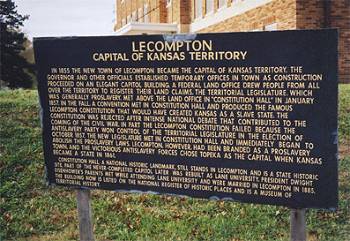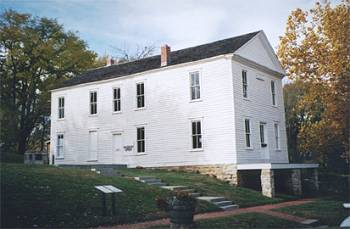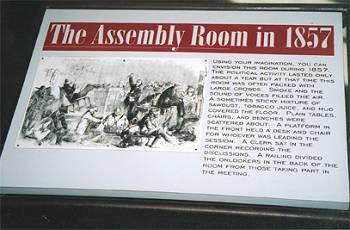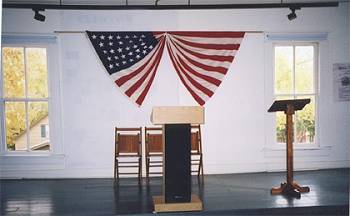|
Bleeding
Kansas Kansas Territory-Prelude
to Civil War: By the mid-1850s Americas great untamed West was expanding rapidly. Up
until that time a delicate balance of power had been maintained in
Congress between pro-slavery states and free states. Several compromise
acts had been passed by Congress including the Missouri Compromise, the
Compromise of 1850 and the Kansas-Nebraska Act which opened the Kansas
territory for settlement. The solutions, however, were only temporary and
the nation became increasingly divided over the status of slavery in new
states admitted to the Union.
The latest of these compromises, the Kansas-Nebraska Act, passed by
Congress on May 30, 1854, represented one last desperate attempt to
mediate a divided nation and maintain the delicate political balance. The
Kansas-Nebraska Act maintained that the question of slavery in the new
territories be determined by the residents themselves. This stipulation
became known as Popular Sovereignty and led to territorial conflict
between pro-slavery and anti-slavery factions.
By 1856 the political tension that captured the nations attention
escalated into violence as incident after bloody incident erupted from
this hotly contested rivalry between pro-slavery and anti-slavery forces.
Anti-slavery Jayhawkers clashed with Bushwhackers from neighboring
Missouri as the two sides were provoked to bitter and often bloody
struggle in Kansas Territory to sway popular decision to their own favor.
The two sides descended upon the territory and conflicts arose as each
side sought majority control. Confrontation and deadly skirmishes over the
issue of slavery would continue in the Kansas Territory for 5 years in an
era to be forever known as Bleeding Kansas.
The conflict in the Kansas Territory further strained already troubled
relations between North and South. The struggle over control of the
Territory was disputed both by militants on the local level and
politicians on the national level. The political turmoil brought about by
the Kansas-Nebraska Act contributed to the birth of the Republican Party
in 1854. The anti-slavery stance of the new political party became a topic
of the Lincoln-Douglas debates in 1858 and attracted national attention.
Pottawatomie Massacre:
Then, in one of the most famous events in the Bleeding Kansas era, radical
abolitionist John Brown (of Harpers Ferry fame) led a small band of
followers including four of his sons, to murder five pro-slavery settlers
on the night of May 24, 1856. The brutal slayings, committed with
artillery swords, were supposedly in retaliation for previous events in
territorial Kansas including the murder of free state men. Perhaps another
factor which led the radical and vicious Brown to such a horrible act was
the savage caning of Massachusetts Senator Charles Sumner in Washington
which had taken place just days earlier.
Marais des Cygne Massacre:
On May 19, 1858 an armed action took place that answered Browns murderous
fanaticism of 1856 and again focused the nations attention on Bleeding
Kansas. On the far eastern front of Kansas Territory, near Trading Post
and the Marais des Cygne river (tr.Marsh of the Swan) about 30
pro-slavery Missourians, led by Charles Hamelton, seized 11 anti-slavery
free staters, lined up the unarmed men in a ravine and shot them down
killing five instantly and wounding five others. It was perhaps the
bloodiest single incident in the Territory and became known as the Marais
des Cygne Massaacre.
The five-year territorial conflict known as Bleeding Kansas brought the
nation, month by month, inexorably to the brink of Civil War. This brutal
and bloody struggle between free state and pro-slavery factions in Kansas
Territory served both as a warning and a chilling prelude for the terrible
conflict that soon would engulf the entire country. Finally, on January
29, 1861 Kansas was admitted to the Union as a free state. Her struggle
over the still unsettled slavery issue came at terrible cost and provided
a last ominous warning of the peril that awaited a nation. |
|
Lecompton-Capital of Kansas Territory
Enlarge
In 1855 the new town of Lecompton became the capital of
Kansas Territory. The governor and other officials established
temporary offices in town as construction proceeded on an elegant Capitol
building. A Federal Land office drew people from all over the territory to
register their land claims. The Territorial Legislature which was
generally pro-slavery, met above the Land Office in Constitution Hall in
January, 1857. In the Fall, a convention met in Constitution Hall and
produced the famous Lecompton Constitution that would have created Kansas
as a slave state. The constitution was rejected after intense national
debate that contributed to the coming of the Civil War. In part, the
Lecompton Constitution failed because the anti-slavery party won control
of the Territorial Legislature in the election of 1857. The new
legislature met in Constitution Hall and immediately began to abolish the
pro-slavery laws. Lecompton, however, had been branded as a pro-slavery
town and the victorious antislavery forces chose Topeka as the capital
when Kansas became a state in 1861.
Constitution Hall, a national historic landmark, still stands in Lecompton
and is a state historic site. Part of the never-completed capitol later
was rebuilt as Lane University. President Dwight Eisenhower's parents met
while attending Lane University and were married in Lecompton in 1885. The
building now is listed on the National Register of Historic Places and is
a museum of Territorial history |
|
Constitution Hall
Built in 1856, Constitution Hall was one of the busiest places in
Territorial Kansas. One of the oldest wood frame buildings in Kansas,
Constitution Hall in Lecompton is the site where, on October 19, 1857,
pro-slavery territorial legislators adopted the ill-fated Lecompton
Constitution that protected slavery in the new territory. Because of its
far-reaching importance, however, the document, supported by Democratic
President James Buchannan, was debated at a national level and was later
defeated by Congress and never took effect |
|
Constitution Hall
(The Assembly Room in 1857)
Enlarge
Using your imagination, you can envision this room during
1857. The political activity lasted only about a year but at that time
this room was often packed with large crowds. Smoke and the sound of
voices filled the air. A sometimes sticky mixture of sawdust, tobacco
juice and mud covered the floor. Plain tables, chairs and benches were
scattered about. A railing divided the onlookers in the back of the room
from those taking part in the meeting |
|
Constitution Hall
(Assembly Room) The building also served as a
Federal Land Office where settlers to the new territory filed claims |



